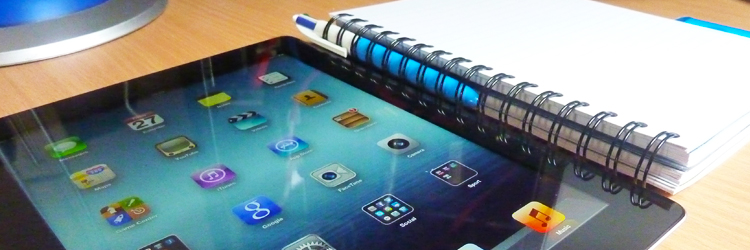Guest blog by April Bowman
Originally from Kansas, USA, April taught elementary school children before coming to Scotland to continue her academic study. She is currently in her final semester of study of the MPP Public Policy Programme at the University of Stirling where her policy specialism has been education policy and teaching practice. April has been with our Knowledge Exchange team for the last two weeks on a voluntary work experience placement.
I used to teach at a school in Las Vegas that had a BYOD (Bring Your Own Device) policy. These policies are becoming more widespread, especially since so many of us now carry our own phones, tablets, and laptops around with us.
The ever-present technology allows us to be as connected and informed as we want, at any time that we choose. Sometimes, adults lament over how members of the younger generations are glued to their technology. But BYOD (also sometimes called BYOT – Bring Your Own Technology) policies at schools can help to keep kids engaged by allowing them to interact with education content, rather than merely the latest clickbait.
Schools and classrooms all over the UK are embracing BYOD, and employers are too. There are many documented benefits of BYOD including:
- Classroom management – BYOD can be used as a reward or privilege to encourage positive student behaviour. This type of behavioural incentive can be used not only for individual students, but also for classes as a whole.
- Connectivity – Integrating personal devices into school has the potential to increase engagement and connection between students, teachers, and parents.
- Engagement – Many students always have a device with them. If you teach students how they can use the device for educational purposes at school, they may be more likely to access the same content outside of school.
- Cost savings – If students can bring their own device, the school won’t have to buy a device for that student. This however is a controversial point of BYOD (see below).
- Saves time – Students are already familiar with their personal device, so they spend more time learning about content and less time learning how to use a new device.
Of course, BYOD can also present challenges. Some of these include:
- Technology funding – Some critics believe that the money saved by not having to purchase a large number of devices will have to be spent supporting the network for the students’ own devices. In addition, money will also have to be found to fund learning content tailored for electronic devices.
- Technology access – Some argue that BYOD in practice highlights student socio-economic inequality. Not only will students be able to perceive their peers as being more or less advantaged, based on their ownership of a device, but those without a device may be placed at an educational disadvantage if they cannot access the learning content.
- Data security – This is one of the more complex challenges in the BYOD debate. How can schools ensure that a network’s data is secure? Is your school’s wi-fi network equipped to support numerous devices at the same time? What happens when a student’s NSFS (Not Safe For School) personal photos/messages get hacked through the network? Schools need to be prepared to take preventative measures to ensure that the network is secure—and be prepared to respond when security is breached. This may require hiring additional IT specialists.
- Academic honesty – Of all the challenges that BYOD brings, this seems to be one of the greatest concerns for educational institutions. Owning a device doesn’t necessarily make a student more likely to cheat, but it certainly makes it easier, and potentially more difficult for teachers and administrators to prove (or even be aware of).
- Parent concerns – Parents may be hesitant or unwilling to send their child to school with a costly possession. Some fear the device may be stolen or damaged – which of course raises questions about liability. Most school-wide BYOD policies emphasise that students bring devices at their own risk, and that the school cannot be held liable for a stolen or damaged device. However, if a teacher accidentally knocks it off a desk or another student throws it into the classroom fish tank, schools may find themselves in a more complicated predicament.
The Education Network (NEN) has produced a guidance note on BYOD which discusses the issues and risks in more detail.
The discussion around BYOD feeds into the wider area of technology in education. Across the UK, STEM (science, technology, engineering, and maths) has become increasingly important. As jobs in STEM sectors grow, schools are eager to train the next generation of STEM employees. Naturally, technology is not only a tenet of STEM education, but technology skills are a necessity for young people to thrive in the present and the future. BYOD policies in schools are an important component of meeting the need for technology-savvy students.
Final thoughts
Choosing BYOD policies that work for schools can be a complex process. Classrooms, schools, local education authorities, and government agencies must consider how to design their policies to enhance student learning and skills, while ensuring that the policy protects the students and staff from harm and legal conflict.
CESG, the National Technical Authority for Information Assurance within the UK has produced guidance for public authorities on considering the security aspects of BYOD.
Read some of our other blogs on education:
- Why do more girls than boys go on to higher education?
- The myth of the digital native? Young people, education and digital participation in Scotland
- Brain food: the impact of breakfast on children’s educational attainment
- Preventing extremism in schools…implementing the strategy
Follow us on Twitter to see what developments in public and social policy are interesting our research team.
Share
Related Posts
Supporting residents on the decarbonisation journey: leveraging data for effective retrofit projects
As the drive towards decarbonisation intensifies, the social housing sector’s ability to collect, store and manage vast amounts of data becomes increasingly critical. With a shared goal of creating warmer, carbon-free homes, housing associations’ strategic use of data is essential ....
A recent item on BBC Radio 4’s Today programme generated an unusually high number of responses from listeners. A man who had lost his job in the financial services sector at the age of 57 described his difficulty in trying ....
By Donna Gardiner While free school meals (FSM) have been available in England on a means-tested basis since 1944, recent years have seen a renewed focus upon the potential benefits of providing free school meals to all school-aged children. Currently, ....
By Robert Kelk and Chris Drake A new start for an old challenge? The recent appointment of Marc Lemaître as the European Commission’s director general for research and innovation (R&I) has returned Europe’s R&I gap to the spotlight. Previously head ....



